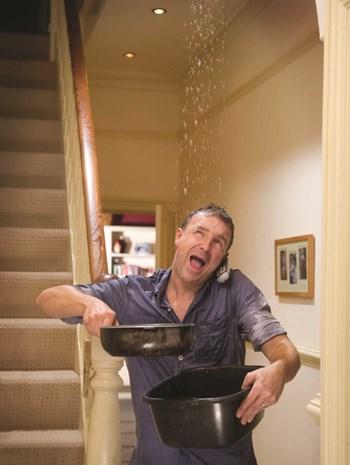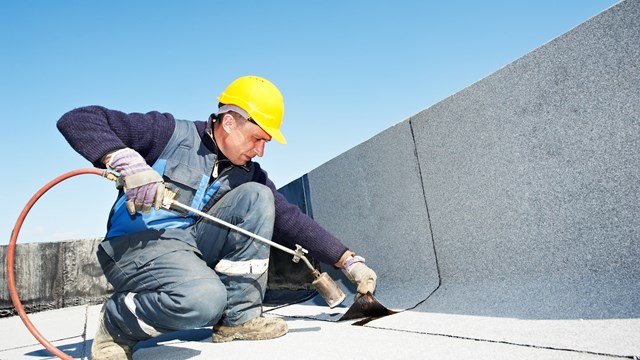
As we go about our busy lives, we often forget about the plain facts of life here on this spinning globe: gravity creates an unceasing tension in the materials we assemble into buildings and other structures. Whether or not we are paying attention, all of matter is reacting to gravity’s pull, and those forces can result in small tears or holes in facades, roofs and other parts of a building.
Over time, such stresses can result in a hole in a roof, oftentimes at a plane change area, such as where flashing surrounds a chimney. Even if it’s just a pinhole leak to start, if it is left undetected for very long, that dripping water can cause serious damage to a building and even adversely affect its structural integrity.
Water leaks are the bane of many homeowners and many condominium superintendents. But unlike a drippy faucet or a drafty window, which often can be simply fixed, water leaks sometimes can be very difficult to find and remedy. Many different technologies exist to help find the source and the extent of leaks and other technologies can help minimize the damage these leaks cause. Knowing what makes leaks happen, the ways that they are found, and how they’re repaired is essential for anyone living in a multi-family building. Because after all, such a leak might happen in nearly anyone’s unit and still affect everyone in the condo because of a costly fix that all will have to pay for.
Spotting Problems
A longstanding leak might signal the need for a major building improvement project, but it might also require a less invasive solution, such as a spot replacement of just part of a roof. Knowing what solution to use is the contractor’s bailiwick, but understanding something about the fixes for water leaks, and the best practices for finding the source of the leaks, is the responsibility of each building resident.
Water leaks in a condo building are generally of two kinds: rain-related or plumbing-related. “The simple difference between a rain-related leak and a plumbing related leak is if somebody is taking a shower upstairs from you or flushing the toilet upstairs from you and you have water going into your kitchen drain, that’s plumbing related,” says Ralph Noblin, P.E., president of Noblin & Associates, a consulting engineering firm based in both Bridgewater, Massachusetts and Dover, New Hampshire. “In a high-rise situation there is a ton of water in pipes. There are water heaters, washer and dryer hook-ups, so plumbing leaks. This happens constantly with condominiums and with absentee owners it’s becoming more of a problem. Say there’s this guy and he owns the windows in his condo because that’s what it says in the condo docs. So he waits forever to replace them. So when it rains, water comes in and it trickles down into the unit six floors below. So water leakage in condo units from rain events is common.”
Experts agree that roofs are the most common source or point of origin for leaks.
“There could be multiple issues with roofs. Especially flat roofs,” says Michael Norman, president of Abbot Building Restoration in Boston, Massachusetts. “Penetration could come from the roof, which could be from air-conditioning units or vents from bathrooms and kitchens. Leaks can occur around those areas. Once water gets into the roof and insulation gets wet, that could be a bad situation. What happens with a flat-roof building is there’s usually insulation underneath the roofing system, underneath the membrane. Wet insulation could lead to mold. The way you can tell if the insulation is wet is if you walk on the roof and your foot sinks in, that’s a sure sign that the insulation under the membrane is wet.”
“Defective roofing has been the number one source of construction litigation since forever and not by a little bit, by a lot,” adds Noblin. “At one point 60 percent of construction lawsuits had to do with leaky roofs.”
A leak doesn’t always have to be particularly severe before residents notice water stains or seepage in the walls or ceiling, and some leaks will show up more or less immediately. Other leaks could be happening for weeks before anyone notices. Some leaks might not be evident in any way, such as a pipe leak for which the building’s management can’t find the source. Such a leak might initially be detected through the water meter on a building’s heating system.
One common water-related issue in multifamily buildings is leaking pipes that are connected to steam boilers. In these systems, condensate return lines are buried in the floor and can develop leaks. Such a leak is first detected through the boiler’s water meter indicating that the system is losing water. At that point, a building’s management team should have experts bring in monitoring equipment to find the leak.
These days, infrared or “thermal” imaging often is used to find a leak’s source. Since a leak in a multifamily building can come from different spots on a large surface such as the building’s exterior, thermal imaging covers all of that territory by looking for a temperature signature on the surface that indicates where the leak is located. The technology helps a professional to find areas of the building that are water-damaged. When used on a roof, a thermal imaging device scans the surface horizontally, detecting where moisture is trapped within the roof.
“There’s a number of different ways you can detect water leaks,” says Kieran Fitzgibbon, president of Statewide RM, Waterproofing & Masonry Restoration in Brookline, Massachusetts. “If it’s a wind-driven rain you could try to recreate the situation by doing a water test. You can do a water test with a high pressure water hose, depending on whether it’s a single source leak; you would typically walk the façade from the bottom up. Also sometimes involved in water testing is a little investigation. You can remove some brick or remove some sheet rock on the ceiling of the interior so you can see where the water is entering the interior.”
Another fairly routine way of inspecting a building to find water leaks is doing a roof survey. In a roof survey, the building’s management will call in a professional, who will do a thermal imaging survey of the entire roof. He will also take photos of the roof and then mark with paint any damaged area of the roof. Generally, a professional will offer spot fixes of the roof when small parts of it are damaged or leaking.
“If a large portion of a roof is leaking, it is almost always better to replace the roof than fix the leak,” says Norman. A repair is a repair and repairs are only temporary. If it’s a flat roof, absolutely replace it. The problem with a flat roof is that even though you have a bad section where the leak is coming from, it might not necessarily be coming from that section.”
The single most effective preventative step to take to avoid roof leaks is proper gutter and downspout maintenance. Make sure these parts of the building are always clear and free of obstructions, by regularly cleaning them.
One method of detecting leaks in a roof sort of imitates what happens when a gutter or downspout is clogged—it backs up water onto one part of the roof. By creating a dam made of sheet metal around an area of a flat roof surface and then applying water to that area where the leak was, specialists can trace a leak to see where the water is coming into the building.
Some companies, like American Leak Detection, stick strictly to the inspection side of this business. The company finds water leaks non-invasively—without excavation or demolition. For exterior water penetration issues, American Leak Detection uses thermal imaging technology and also electric vector mapping, which employs an electric current and water to find even a pinhole-sized tear.
Whether or not a unit owner hears a drip coming from the roof or elsewhere, such a leak might be making a sound that still is detectable. Specialists sometimes use ultrasound technology to hear and find an active leak of water or steam. This technology isn’t used on roofs, for obvious reasons—it’s too loud outside for the technology to work.
Repairing Leaks
The most common source of water leaks in suburban multifamily buildings is the roof. Areas of the roof where flashing is used typically are the weakest points on the roof surface, and are the spots most likely to develop a leak. Because each leak is unique, there’s no rule of thumb for how long it can take to find a water leak. Finding the source of the problem might take just a couple of hours, or it might require many hours of work, depending upon the size of the property.
Costs for bringing in a leak detection specialist vary. Several different types of professionals are qualified to do the job, including firms that refer to themselves as leak detection specialists, as well as engineers or contractors with expertise in the area. Hiring such professionals can start at $600 per man per day, and often two men are needed to inspect for a leak problem. Some day rates range upwards of $2,000.
Knowing how to pick the right company to handle the job is a matter of matching up skills and needs. For example, if the leak is isolated to just several units, a company such as American Leak Detection could find the source of the problem.
For a whole building leak problem, management always should consult the building’s engineer regarding how to proceed. If they pay attention, though, owners and management will be able to pick out the best firms to do the work, based in part upon what they say.
When they are found, leaks are repaired in various ways. If the leak is in the area of flashing around a chimney, for example, the flashing might need to be replaced and repainted. The type of fix for a leak always is dependent upon the type of problem, but conditions of the building material that is affected, the age of the building component (such as a roof, stone façade, or even steel window lintels), and the size and scope of the leak all factor into a remedy. The amount of damage caused by the leak also is part of the equation.
Sometimes the leak is in the middle of the basement floor of a building. What’s happening in such a case is that the water table underneath the building is rising and falling because of rains that soak the soil and seep up into the basement.
To fix this type of problem, a contractor will install a water-tight membrane on the basement floor and up the basement walls at least eight inches and as high as a few feet. The same method can be used to seal an elevator pit, which is essential to safeguard all wires in the building.
Other basement leak fixes could be much more invasive. Some buildings have basement water problems because their exterior brick walls are porous due to moisture coming through them. In these scenarios, the water is coming through because the brick is in contact with a water source leaching from the soil. So, a contractor must excavate to the base of the building to get to the root of the problem. This fix involves moving soil and landscaping, and the logistics can get pretty complicated.
Not every contractor will give an ironclad guarantee on his work, but many are passionate about their jobs, and dedicated to helping their clients. These are the specialists that a building’s management should be working to find, because they will do the job right.
Jonathan Barnes is a freelance writer and a regular contributor to New England Condominium and other publications. Staff Writer Christy Smith-Sloman contributed to this article.






Comments
Leave a Comment